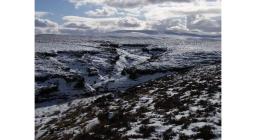Permafrost response and feedback under temperature stabilization and overshoot scenarios with different global warming levels
Permafrost in the northern high latitudes faces significant degradation risks under global warming and this threatens the achievement of global climate goals. This study explores the response and feedback of permafrost and the associated carbon loss under temperature stabilization scenarios, where the global mean temperature stabilizes at various global warming levels, and overshoot scenarios, and where the global mean temperature temporarily exceeds the 1.5 °C warming target. Under the 1.5 and 2 °C stabilization scenarios, permafrost area is projected to decrease by 4.6 (4.5 to 4.7) and 6.6 (6.4 to 6.8) million km2, respectively, from a pre-industrial level of 17.0 million km2. Corresponding permafrost carbon losses are estimated at 54 (32 to 79) and 72 (42 to 104) PgC, relative to a pre-industrial carbon stock of 484 (383 to 590) PgC. In overshoot scenarios, permafrost area shows effective recovery, with additional losses of only 0.6 (0.3 to 1.1) million km2 compared to the 1.5 °C stabilization scenario. In contrast, permafrost carbon loss remains largely irreversible, with additional loss of 24 (4 to 52) PgC compared to the 1.5 °C stabilization scenario. Both stabilization and overshoot scenarios show that additional warming due to permafrost carbon feedback rises with higher global warming levels, and the additional warming in overshoot scenarios becomes most pronounced during the cooling phase. The additional permafrost area loss due to permafrost carbon feedback, which accounts for 5 (2 to 11) % of the total loss, is influenced by both the magnitude of additional warming and the sensitivity of permafrost area to global warming. Moreover, the responses of permafrost area, permafrost carbon, and associated radiative forcing to a broad range of global warming exhibit near-linear relationships under stabilization scenarios. Based on the simulations presented, permafrost carbon feedback is unlikely to initiate a self-perpetuating global tipping process under both stabilization and overshoot scenarios. These findings have significant implications for long-term climate change and mitigation strategies.
Cover photo: Relationship between global warming levels and three permafrost metrics: (a) permafrost area loss, (b) permafrost carbon loss, and (c) permafrost radiative forcing in the stabilization (colored dashed lines) and overshoot (colored solid lines) scenarios for 1.5 °C (orange), 2.0 °C (brown), 3.0 °C (green), and 4.0 °C (purple) global warming levels, along with the SSP5-8.5 scenario (black). Square and circle markers indicate values in the year 2300 for the stabilization and overshoot scenarios, respectively. All results are based on the PFC simulations. Grey solid lines show linear fits of permafrost metrics to global warming levels in stabilization scenarios by 2300, while black dashed lines show corresponding fits for the SSP5-8.5 scenario. Note that in panel (a), both the stabilization scenarios and the corresponding SSP5-8.5 points included in the linear fit are limited to global warming levels between 1.5 and 3.0 °C, whereas in panels (b) and (c), the fits include points with global warming levels ranging from 1.5 to 4.0 °C. For stabilization scenarios, only the results from the year 2300 are used for fitting, while for the SSP5-8.5 scenario, all results within the specified global warming level ranges are used for fitting. Shaded regions represent the 5th to 95th percentile ranges across 250 ensemble simulations.


